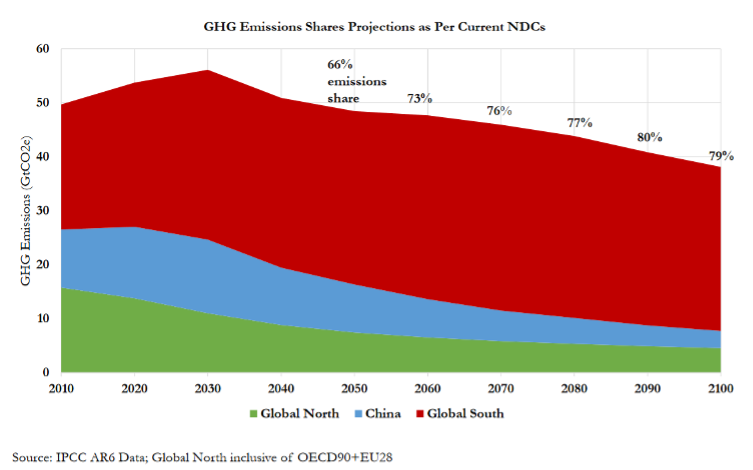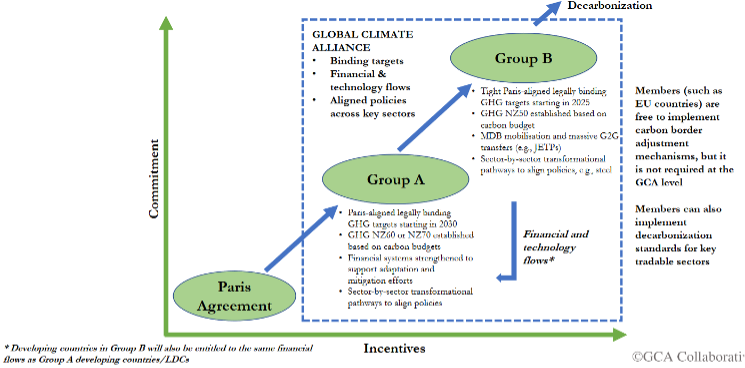Establishing a Global Alliance to Accelerate Climate Action
Vedant Monger, December 12, 2022
Climate-related disasters have become more frequent in recent years. Most notable among recent events was the unprecedented flooding, a conflation of glacial melting and extreme rainfall that submerged about a third of Pakistan in water. Temperature rise is predicted to reach about 2.8°C by end-of-century. A warmer earth would kick off a chain of cataclysmic disasters. To avoid extreme climate change, the Paris Agreement set an anchor of limiting temperature rise to 2°C. Towards that end, several countries in the Global North have committed to stringent emissions reduction targets. Similarly, China has already committed to a peaking target of 2030 and will reach Net Zero Emissions by 2060.

The challenge lies in reducing emissions from the remaining Global South countries simply because they do not have enough investible capital to decarbonise. India alone would need to double its current level of capex investments, about $100-115 billion, in the forthcoming decade to decarbonise its economy. Projections foretell that with current climate policies, the Global South will account for about 80 per cent of global emissions by end-of-century. Finance worth trillions would need to flow to the Global South to get the Global South to reduce their GHG emissions. In return, the Global South would need to commit to accelerating climate action.
The Global Climate Alliance: Membership for all
The Global Climate Alliance (GCA) is a proposal for an alliance between the Global North and the Global South to accelerate climate action. The Alliance would be a quid pro quo deal between countries in the Global North and countries in the Global South who would commit (in law, policy, or NDCs) to hard binding targets on reducing economy wide GHG emissions anchored in a Net Zero target. In return, countries in the Global North would have to make similar hard commitments to divulge financial resources towards mitigation and adaptation in the Global South. In line with the common but differentiated responsibilities (CBDR) principle, the Alliance would have two tiers—a Plan A where members commit to less stringent emissions reduction targets (for e.g., Net Zero by 2060/70); and a Plan B where members commit to more stringent targets (Net Zero by 2045/50). In turn, the financial flows that countries would receive would be commensurate with their commitments. A report on the proposal was formally launched at COP 27 by Shri Jayant Sinha, Chairperson of the India Parliamentary Standing Committee on Finance.
Rethinking Climate Finance in the GCA
The most crucial component in climate agreements, also the deadlock, has been climate finance. From the lens of climate finance, the deal would be compatible with the interests of countries involved in the deal. Firstly, financial flows from the Global North would predominantly be commercial return-seeking capital. Investments tackling climate change, such as renewables and resilient infrastructure, are mostly return generating. The commitments from the Global North countries would be directed toward scaling the balance sheets of MDBs, DFIs, and multilateral institutions. These institutions would then leverage this capital through novel risk-compensating financial instruments such as currency swaps.[1]

There are a variety of ways to raise finance— Special Drawing Rights (SDRs), scaling Overseas Development Assistance (ODA) and Tobin taxes. The Global North would have to sacrifice modest budgetary outflows and returns generated would ultimately benefit Global North companies and investors. The second-order benefits to the Global South would accrue in stronger and resilient economic growth and better public health outcomes. Indeed, several modelling studies have demonstrated that ‘Net Zero is Net Positive’ for economies in the Global South. However, for the Global South to receive vast amounts of financial flows, their financial systems would have to be reengineered. Green investment agencies and a clear taxonomy of what investments count towards green would make it plausible for catalysing trillions of dollars.
Concurrently, countries in the Alliance would work sector-by-sector to decarbonise. A Working Group for Steel, for instance, would identify how the steel industry could transition toward greener steel. Thereafter, countries could align their transformational pathways, policies and standards under the Alliance. Such piecemeal efforts would count towards the larger emissions-reduction mandates. The GCA builds on Germany’s Inclusive Climate Club proposal. It proposes an inclusive, incentive-compatible approach toward solving a global problem. Ultimately, it would be a win-win-win deal. For the planet, for the Global North, for the Global South.
[1]https://economictimes.indiatimes.com/opinion/et-commentary/g20-presidency-india-can-unleash-a-green-frontier-development-model-that-will-drive-competitiveness-jobs-gdp-growth/articleshow/96010202.cms
Vedant Monger is Consultant–Climate Insights at Shakti Sustainable Energy Foundation

